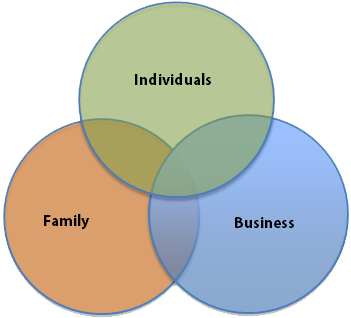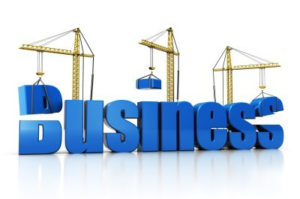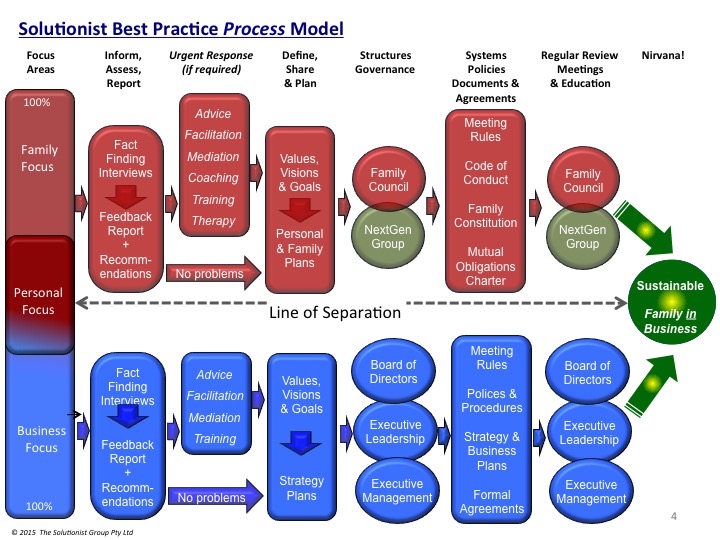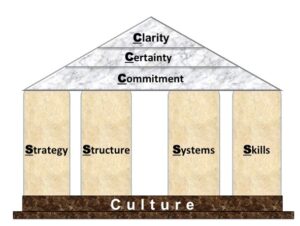“Families and businesses come from different worlds. They dance to different tunes. Logically, you’d never mix them. So if you do, you must plan well and work extra hard to build long term peace and prosperity. ‘Hope’ and ‘Luck’ don’t survive long in this equation”
Family Business needs should be approached warily, and treated as a multi-dimensional enigma. They’re a compound of Individual, Family and Business interests and motivations, and it’s only by addressing each of these elements, appropriately and in the right sequence, that we can design, develop and deliver optimal solutions.
Family Alignment
Love? Like? Respect? Trust? Peace? Harmony? Happiness? Cohesion? Affection? Togetherness?
Every family wants them; but so many suffer disappointment. We put them all under the heading of “Family Alignment”. Once we get the whole family, or at least whoever wants to play, on the same page – with everyone pointing the same way, and travelling at the same speed – most of these “desirables” just happen. No force, no drama, it just happens.
And then it’s up to the family to keep working on keeping things sweet. How you do that in the future is an integral part of our process.
Family Business Difference
Business is business and the rules of commerce haven’t changed much since the serpent traded with Eve over an apple, but bring family dynamics into a commercial environment and you introduce an extra dimension full of energy, emotion and complexity. This is the family business difference. It brings effortless peace and prosperity to some families, and endless stress and challenge to others.
Long-term success means having a happy family AND a strong business.Some families spend generations working out how to get both.
Do you want to take that long? If not, we can help to shorten the process AND lessen the risk, pain and expense. Read on, or just contact us now.
3 Elements Approach
When you consider family business challenges, where’s your main focus: personal, family, or business issues?
Do you find personal and family stuff getting in the way of your business? We do, all the time. Our 3 Elements Model reflects this by recognising and responding to the paramount importance of individuals, and what drives them. If you can’t do a good job of managing individual needs and interests, anything else you try to do is unlikely to work well, or for long.
3 Elements Model of Family Business:
We commence every assignment by interviewing every key individual, privately, to get a good feel for “who’s who in the zoo” and whatever their personal perspectives, hopes, wishes, issues and concerns might be. This often brings additional issues to the surface, some of which may have been smouldering away for years, just waiting to erupt.
As soon as the interviews are complete we produce a “helicopter view” report describing:
- The current state of the family, as it appears to our independent and experienced eyes;
- Issues that need to be resolved before things can proceed safely;
- Recommendations that respond to the family’s specific needs – for the family and its business.
Family Business Dynamics
Family systems are fundamentally different to business systems. Their contrary dynamics create tensions, on many levels, even in the “best” families:
Family Business Dynamic Tensions
| Competitive | Protective | |
| Objective | Emotional | |
| Task-based | Obligation-based | |
| Results-oriented | Relationship-oriented | |
| Select best person for the job | Status by birthright | |
| Performance | Loyalty | |
| External focus | Internal focus | |
| Survival of the fittest | Nurture and support weakest | |
| Encourage/exploit change | Minimise change | |
| Employment by competence | Employment by relationship | |
| Employment is an opportunity | Employment is a right |
Family dynamics need to be actively managed when there’s a family business, and a family legacy, in the mix. This is what the family business best practice model offers – tried and tested strategies, structures and systems designed to produce a “happier family and a stronger business”.
Family Business Life Cycle
As individuals we have finite life spans, bookended by birth and death. Life fills the space in between; kicking off with growth and development, followed by mature activity, advancing to teaching and mentoring, before inevitable decline and decay.
Theoretically, our families and businesses can continue forever, through a process of constant renewal – provided they survive challenges and adapt to change. This is pure Darwin: “It is not the strongest of the species that survives, nor the most intelligent, but the one most responsive to change.”
The good news is that major challenges and changes can be predicted, so we can plan for them, and respond accordingly, by understanding where we are in the family business lifecycle:
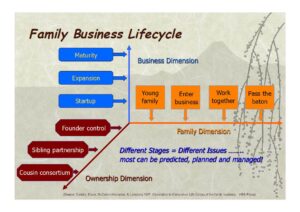
Family Business Best Practice
Experience, anecdotes and extensive research all tell us that the surest way to damage your family AND your business is to leave things to chance and let things work themselves out.
The second fastest route to destruction is through blindly following inappropriate advice given by well-meaning, but fundamentally uninformed relatives, friends and advisers.
To overcome inescapable challenges and to achieve your desired outcomes, you need to: “do the right things, the right way, with the right people, at the right time”.
In an ordinary business, this is simply the well-trodden path of “Best Practice”.
It’s harder for family businesses, due to their uniqueness and the family business difference, but that doesn’t reduce the need for a workable best practice model. In fact, it increases it.
We put everything we’ve discovered, developed, used and found successful into such a Best Practice Model for family business. The Model helps us to guide our clients through every issue, challenge or conflict we’ve seen over the past 20+ years.
While there are never any guarantees of success, we believe it offers most families the best chance they’ll get of sustaining a happy family and a strong business, over the long term. The model looks like this:
7 Elements of Family Business Success
Almost all long term successful and sustainable business families have one thing in common: they worked really hard to establish and maintain the 7 Elements of Family Business Success.
Because every family and every business is different, the 7 Elements need to be approached and adopted as flexible guidelines, rather than as rigid rules:
3x “Cs” = main concepts (roof):
Clarity + Certainty + Commitment
4x “Ss” = support for concepts (pillars):
Strategies + Structures + Systems + Skills
Of course, everything needs to be built on strong foundations, or the best intentioned, magnificently designed plans are destined to fail. Underpinning everything is the Culture of the family, and how it translates in the family business.
There are few truer sayings than: “Culture eats Strategy for breakfast”, meaning that all the good intentions in the world don’t amount to a row of beans if they’re not supported by real and appropriate actions: “the way we do things around here” – that’s culture.
So when we put everything together well, we create a strong and lasting structure. I visualise the 7 Elements as a temple:
Family Business Challenges
Common Issues, Challenges and Conflicts
Your family and business are unique, however your issues have almost certainly been faced by many other families in the past, in some form or other, and will be faced by countless more in the future. By tapping into the accumulated knowledge and experience of the ages to guide your choices, you can avoid having to work everything out for yourself. This should save you and your family considerable pain, damage, effort, time and cost.
Here’s a small selection of the issues that seem to create problems, again and again:
Business Focus
- Lack of clarity: undeclared objectives and plans for the future.
- Lack of clarity: job descriptions; individual roles and responsibilities.
- Lack of clarity: systems and policies.
- Professionalising the business: maximising its profitability and value.
- Business ownership – structure issues. Transfer of equity.
- Business continuity, leadership transition and succession plans – when and how.
- Business leadership and management – do family members have the necessary talent and/or commitment for current needs? For the future?
- Low trust environments.
- Weak communication, problem solving and decision making processes and skills.
- Family employment: performance expectations and expected behaviours.
- Remuneration and rewards for working and non-working family members.
Family Focus
- Lack of clarity: undeclared objectives and plans for the future.
- Professionalising the family: harmonious teamwork to protect and enhance the family’s capital, and its legacy.
- Clashing values, needs and objectives, especially: Ownership vs Stewardship.
- Dysfunctional family relationships and challenging behaviours.
- Emotional baggage and challenging behaviours.
- Poor communication skills and systems.
- Poor decision making, or (almost) no decision making. “Fossilisation!”
- Inter/intra-generational rivalry, competition and conflict.
- Low trust environments.
- Engaging the interest of current and future generations of the family – in the business and even in the family.
- Equality vs Equity amongst family members.
Family and Business Focus
- What’s the plan? Is there a plan? What’s expected of me? What’s in it for me?
- Balancing business needs with (unrealistic?) family expectations.
- Financial needs and security: the business vs the family vs the individuals.
- Need / desire to professionalise the family and the business.
- Separating business from family decision making.
How we can help
We approach every family business situation as a problem that needs to be solved to produce the best possible outcomes for each individual, AND the family AND the business.
We look at the whole picture to ensure that nobody, and no thing, is sacrificed for the sake of expediency. Our aim is always to: defuse stress, confusion and conflict; minimise pain and hurt; repair relationship damage; increase learnings and skills; and maximise prospects for positive, sustainable outcomes for everyone involved. And to do it all as cost-effectively as possible.
Call us now for a confidential conversation about your needs, without any obligation. It may be the most important call you make this year.

